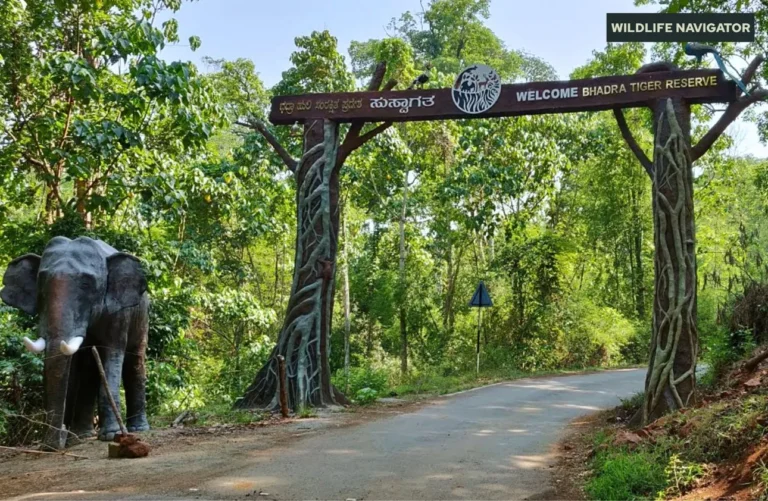Asian Elephant | Elephas Maximus – Habitat, Diet, Facts & More

The Asian Elephant (Elephas maximus) is one of the most iconic and gentle giants of the animal kingdom. Known for their intelligence, social behaviour, and immense size, these majestic creatures have roamed the forests and grasslands of Asia for millennia. Unlike their African counterparts, Asian elephants are slightly smaller, with distinct features such as smaller ears and a more rounded back.
Asian elephants play a crucial role in their ecosystems. As mega-herbivores, they help shape forest landscapes, disperse seeds, and maintain biodiversity. Beyond their ecological importance, they hold immense cultural and religious significance in many Asian countries, often featured in folklore, temple ceremonies, and festivals.
Despite their importance, Asian elephants face numerous threats, from habitat loss and poaching to human-elephant conflict. Conservation efforts have become critical to ensure these gentle giants continue to thrive in the wild.
Physical Characteristics
The Asian Elephant is a remarkable animal with a unique blend of strength, intelligence, and grace. Adult males, known as bulls, can weigh between 4,000 to 5,500 kg (8,800 to 12,000 lbs) and reach heights of 2.7 meters (9 feet) at the shoulder, while females are slightly smaller, weighing 2,700 to 3,500 kg (6,000 to 7,700 lbs) and standing around 2.4 meters (8 feet) tall.
Key Features:
- Ears: Smaller and more rounded compared to African elephants. Their ears are adapted to help regulate body temperature.
- Tusks: Only some males have tusks, called “tuskers,” while females usually have very small tusks or none at all.
- Trunk: A highly versatile organ with over 40,000 muscles, used for feeding, drinking, communication, and bathing.
- Skin: Thick, grey, and wrinkled, providing protection from heat and insect bites. Patches of pink skin may appear around the face and ears.
- Back: Slightly rounded, unlike the concave back of African elephants.
Lifespan: In the wild, Asian elephants can live up to 60 years, while those in captivity often live slightly shorter lives due to environmental and health factors.
Sexual Dimorphism: Males are larger with more prominent tusks, while females are smaller and play a crucial role in maintaining herd dynamics.
Fun Fact: Despite their massive size, Asian elephants are surprisingly agile. They can swim long distances, climb slopes, and even use tools, such as branches, to swat insects.
Habitat and Distribution
The Asian Elephant is native to various regions across South and Southeast Asia. Unlike African elephants that prefer open savannas, Asian elephants thrive in dense forests, grasslands, and wetlands, adapting well to different landscapes depending on the availability of food and water.
Geographical Distribution:
Asian elephants are primarily found in 13 countries, including:
- India: Home to the largest population, concentrated in states like Assam, Kerala, Karnataka, and West Bengal.
- Sri Lanka: Known for its smaller, island-specific subspecies.
- Nepal, Bhutan, and Bangladesh: Mostly in forested regions near rivers and protected reserves.
- Southeast Asia: Thailand, Myanmar, Laos, Cambodia, Vietnam, Malaysia, and Indonesia host smaller populations, often fragmented due to habitat loss.
Preferred Habitat:
- Tropical and Subtropical Forests: Dense forests provide shade, protection, and a diverse range of plants for feeding.
- Grasslands and Savannahs: Open areas allow easy movement and grazing.
- Wetlands and River Valleys: Vital for drinking, bathing, and cooling down during hot days.
Habitat Challenges:
Urbanisation, agriculture, and deforestation have fragmented elephant habitats, forcing them into human-dominated landscapes, which often leads to conflict. Wildlife corridors and protected reserves play a crucial role in connecting these fragmented habitats and supporting healthy populations.
Behaviour and Social Structure
Asian elephants are known for their complex social behaviour and intelligence, making them one of the most fascinating species in the animal kingdom. Their interactions are highly organised, emotional, and guided by strong family bonds.
Herd Dynamics:
- Asian elephants live in matriarchal herds, typically led by the oldest and most experienced female.
- Herds consist of related females and their young, providing protection and social learning opportunities.
- Adult males, or bulls, usually leave the herd upon reaching puberty and live either solitary lives or form small bachelor groups.
Communication:
Elephants communicate through a combination of vocalisations, body language, and even seismic signals:
- Trumpeting and rumbling: Used to convey emotions such as distress, excitement, or alertness.
- Touch and gestures: Elephants use their trunks and body contact to bond, reassure, or discipline.
- Seismic communication: Elephants can detect vibrations through the ground, enabling them to communicate over long distances.
Daily Activities:
- Feeding: Elephants spend 12–18 hours a day foraging.
- Bathing and mud-wallowing: Essential for skin care, cooling, and parasite control.
- Migration: Seasonal movements help them find water and fresh food, especially during dry months.
Intelligence and Memory:
- Asian elephants are highly intelligent, capable of problem-solving, tool use, and showing empathy.
- They exhibit long-term memory, often remembering water sources, migration routes, and past dangers.
- Emotional intelligence is evident; elephants display grief, joy, and playfulness, strengthening herd cohesion.
Diet and Feeding Habits
The Asian Elephant is a herbivore with a diverse diet that allows it to thrive in various habitats. Their feeding habits are essential not only for their survival but also for maintaining the health of ecosystems, as they help disperse seeds and shape vegetation.
Types of Food:
- Grasses: Form the bulk of their diet in most habitats.
- Fruits: They enjoy mangoes, bananas, jackfruit, and other seasonal fruits.
- Leaves and Bark: Elephants strip bark from trees and feed on tender leaves.
- Roots and Small Plants: They dig for roots and tubers using their trunks.
Daily Intake:
- An adult Asian elephant can consume 150–300 kg (330–660 lbs) of vegetation daily.
- They require 100–200 litres of water per day, making access to rivers and waterholes critical.
Feeding Patterns:
- Elephants are diurnal feeders, often foraging during the early morning and late afternoon.
- They may travel 10–20 km per day in search of food, especially in fragmented habitats.
- Seasonal variations influence their diet, with more fruits and tender vegetation during wet seasons and bark and dry grasses during dry months.
Reproduction and Life Cycle
The Asian Elephant has a slow reproductive rate, which makes population recovery a challenging process. Their life cycle is marked by strong maternal care and long developmental periods, reflecting their intelligence and social complexity.
Mating Behaviour:
- Female elephants reach sexual maturity around 10–15 years, while males mature later at 15–20 years.
- During the mating season, males may enter musth, a period of heightened testosterone, aggression, and increased sexual activity.
- Courtship involves vocalisations, touching with trunks, and following the female to establish bonding.
Gestation and Birth:
- The gestation period for Asian elephants is exceptionally long—around 18–22 months, one of the longest in the animal kingdom.
- A single calf is usually born, weighing 100–150 kg (220–330 lbs) at birth. Twins are extremely rare.
- Calves are dependent on their mothers for nutrition, protection, and learning social skills for several years.
Calf Rearing and Herd Support:
- Mothers are aided by allomothers—other females in the herd—who help in nurturing and protecting the young.
- Calves learn essential survival skills, like feeding, bathing, and interacting with herd members, by observing older elephants.
Life Stages:
- Calf (0–5 years): Fully dependent on mother and herd.
- Juvenile (5–15 years): Begin independent feeding but stay close to the herd.
- Subadult (15–20 years): Males gradually leave the herd; females remain.
- Adult (20+ years): Fully grown, capable of reproduction, and integral to herd social structure.
Lifespan: Wild Asian elephants can live 50–60 years, while captive elephants may live slightly shorter lives due to environmental stresses.
Project Elephant – India’s Pioneering Elephant Conservation Initiative
Launched by the Government of India in 1992, Project Elephant is a flagship program of the Ministry of Environment, Forest and Climate Change (MoEFCC) aimed at protecting Asian elephants, their habitats, and migration corridors. It also works to minimise human-elephant conflict and ensure the welfare of captive elephants.
Key Objectives of Project Elephant:
- Protect wild elephant populations and their habitats across India.
- Establish and maintain Elephant Reserves and wildlife corridors to ensure free movement of herds.
- Reduce human-elephant conflict through community-based management and compensation programs.
- Promote research, veterinary care, and rescue operations for distressed or injured elephants.
- Improve the welfare of captive elephants used in temples, tourism, and forestry.
Achievements and Impact:
- Over 30 Elephant Reserves have been notified across India, covering more than 65,000 sq km.
- The program has strengthened coordination between states for elephant migration routes.
- It supports anti-poaching units, awareness campaigns, and habitat restoration projects.
Connection with National Parks and Reserves:
Many major tiger reserves and national parks in India, such as Bandipur, Mudumalai, and Kaziranga, also function as critical elephant habitats under Project Elephant’s protection, making it a cornerstone of India’s broader wildlife conservation network.
Major National Parks to Spot Asian Elephants
Asia is home to numerous national parks and wildlife reserves where visitors can witness Asian elephants in their natural habitats. These protected areas not only safeguard elephant populations but also preserve the rich biodiversity of the region.
India:
- Jim Corbett National Park – India’s first national park, known for dense forests and frequent elephant sightings.
- Kaziranga National Park – Famous for one-horned rhinoceroses and wild elephant herds roaming the grasslands.
- Periyar National Park – Elephants can often be seen near Periyar Lake during boat safaris.
- Bandipur National Park – Part of the Nilgiri Biosphere Reserve, home to significant elephant populations.
- Mudumalai National Park – Dense forests with elephant corridors linking neighbouring states.
Sri Lanka:
- Minneriya National Park – Famous for the seasonal “Gathering of Elephants”, one of the largest wild elephant congregations in the world.
- Udawalawe National Park – Offers sightings of both wild herds and orphaned elephants being rehabilitated.
Thailand:
- Khao Yai National Park – Thailand’s oldest national park with dense forests where elephants roam freely.
- Kui Buri National Park – Known for sightings of wild elephant herds in open grasslands, ideal for photography.
Other Notable Reserves:
- Way Kambas National Park, Indonesia – Protects critically endangered Sumatran elephants.
- Chitwan National Park, Nepal – Offers opportunities to see elephants alongside rhinos, tigers, and other wildlife.
Subspecies of the Asian Elephant
The Asian elephant (Elephas maximus) is not a single uniform species but has several subspecies spread across different regions of Asia. Each subspecies has adapted to its environment, resulting in slight differences in size, appearance, and behaviour. Understanding these distinctions helps us appreciate their diversity and the unique conservation challenges they face.
Indian Elephant (Elephas maximus indicus)
- Range: India, Nepal, Bhutan, Bangladesh, and parts of Myanmar.
- Appearance: Medium-sized with relatively smaller ears compared to African elephants; more arched back.
- Population: The largest population of Asian elephants, forming nearly 60% of the global total.
- Conservation status: Endangered, threatened by habitat loss, poaching, and human-elephant conflict.
Sri Lankan Elephant (Elephas maximus maximus)
- Range: Exclusively found in Sri Lanka.
- Appearance: The largest among Asian elephants, with males sometimes exceeding 3.5 meters in height; darker skin tone with extensive depigmentation (light patches) on the face and ears.
- Population: Around 6,000 individuals remain in the wild.
- Conservation status: Endangered, mainly due to habitat fragmentation on the island.
Sumatran Elephant (Elephas maximus sumatranus)
- Range: The island of Sumatra, Indonesia.
- Appearance: Smaller and lighter in colour compared to other subspecies; shorter trunk hair and straighter tusks.
- Population: Critically endangered, with fewer than 2,800 individuals left.
- Conservation status: Faces severe threats from deforestation, palm oil plantations, and illegal wildlife trade.
Bornean Elephant (Elephas maximus borneensis) Debated Subspecies
- Range: Northeastern Borneo (Sabah, Malaysia & parts of Indonesia).
- Appearance: Smaller body size, relatively larger ears, longer tail often reaching the ground, and gentler temperament.
- Population: Estimated 1,500–2,000 individuals.
- Conservation status: Considered endangered; some scientists debate whether they are a true subspecies or a long-isolated population of Sumatran elephants.
Extinct Subspecies (Historical Records)
- Syrian Elephant (Elephas maximus asurus) – Once found in West Asia (Syria, Iraq, Iran). It became extinct around 100 BC.
- Chinese Elephant (extinct population) – Once roamed central and southern China, but now survives only in small pockets of Yunnan Province.
Threats and Conservation Status
The Asian Elephant is classified as Endangered on the IUCN Red List, with populations declining due to a combination of human-induced and environmental factors. Protecting these gentle giants is crucial for maintaining biodiversity and healthy ecosystems.
Major Threats:
- Habitat Loss and Fragmentation:
- Rapid urbanisation, agriculture, and deforestation have reduced and fragmented elephant habitats.
- Fragmented forests force elephants into human-dominated landscapes, increasing human-elephant conflict.
- Poaching:
- Elephants are hunted for their ivory, skin, and other body parts.
- Although Asian elephants generally have smaller tusks than African elephants, males with tusks are still targeted.
- Human-Elephant Conflict:
- As natural habitats shrink, elephants raid crops, leading to retaliatory killings by farmers.
- Infrastructure like roads and railways often results in accidental injuries or deaths.
- Climate Change:
- Altered rainfall patterns and prolonged droughts affect food and water availability, forcing elephants to migrate further.
Conservation Efforts:
- Protected Areas and Wildlife Reserves: India, Sri Lanka, and Thailand have established sanctuaries and national parks to safeguard elephant populations.
- Wildlife Corridors: Connecting fragmented habitats allows elephants to migrate safely between forest patches.
- Community-Based Initiatives: Educating local communities on coexistence, crop protection, and eco-tourism.
- Anti-Poaching Measures: Patrolling, monitoring, and strict legal enforcement to deter poaching.
Interesting Fact: India alone hosts over 27,000 Asian elephants, making it home to more than 60% of the global population, highlighting the critical role of Indian conservation efforts.
How to Help Protect Asian Elephants
Protecting the Asian Elephant is a responsibility that requires global awareness, community involvement, and sustainable practices. There are several ways individuals and organisations can contribute to the survival of these gentle giants.
1. Support Conservation Organisations:
- Donate to or volunteer with organisations working to protect elephants and their habitats, such as WWF, Wildlife Trust of India, and Elephant Family.
- Contributions help fund anti-poaching patrols, rescue operations, and habitat restoration projects.
2. Responsible Eco-Tourism:
- Visit sanctuaries and reserves that prioritise elephant welfare.
- Avoid attractions that exploit elephants for rides, shows, or performances.
- Support tourism that benefits local communities while promoting conservation awareness.
3. Spread Awareness:
- Educate friends, family, and communities about the importance of elephants and the threats they face.
- Participate in campaigns and social media initiatives aimed at saving Asian elephants.
4. Reduce Human-Elephant Conflict:
- Encourage the use of elephant-friendly barriers like chili fences and solar-powered alarms in conflict-prone areas.
- Promote planting crops that are less attractive to elephants near villages.
5. Advocate for Policy Change:
- Support government policies that protect forests, wildlife corridors, and enforce strict anti-poaching laws.
- Engage with wildlife NGOs to promote sustainable land-use practices.
Cultural and Religious Significance
The Asian Elephant holds a special place in the hearts, religions, and traditions of many Asian communities. Beyond their ecological importance, elephants symbolise strength, wisdom, and prosperity in various cultures.
Religious Significance:
- Hinduism: The elephant-headed god Lord Ganesha represents wisdom, luck, and the removal of obstacles. Elephants are often part of temple rituals and processions.
- Buddhism: Elephants symbolise mental strength and stability. White elephants are particularly revered and considered sacred.
- Other Beliefs: In Southeast Asian folklore, elephants often appear as protectors of forests, kings, or divine messengers.
Elephants in Festivals and Traditions:
- Temple Elephants: In India and Sri Lanka, elephants are decorated with colourful fabrics, ornaments, and paints during religious processions.
- Elephant Festivals: Festivals like the Kerala Thrissur Pooram celebrate elephants with grandeur, attracting tourists worldwide.
- Royal Symbolism: Historically, elephants were used in royal armies, hunting expeditions, and ceremonial events, symbolising power and prestige.
Human-Elephant Relationships:
- In rural areas, elephants assist in logging, transportation, and ceremonial duties.
- Local communities have developed a mutual respect for elephants, balancing cultural reverence with the need to manage conflicts.
Facts About Asian Elephants
Asian elephants are fascinating creatures, and learning amazing facts about them can help people appreciate their intelligence, social behaviour, and ecological importance.
- Exceptional Memory: Asian elephants are known for their long-term memory, which helps them remember water sources, migration routes, and social connections.
- Highly Social Animals: They live in tight-knit family herds, forming strong bonds that can last a lifetime.
- Tool Users: Elephants can use branches to swat flies or scratch themselves, showcasing problem-solving skills.
- Emotional Intelligence: Elephants display grief, empathy, and joy, mourning lost herd members and celebrating reunions.
- Swimming Experts: Despite their size, Asian elephants are excellent swimmers and can cross rivers with ease.
- Gentle Giants: Even though they can weigh up to 5,500 kg (12,000 lbs), elephants often move quietly and interact gently with humans and other animals.
- Cultural Ambassadors: Elephants have been a part of Asian folklore, art, and religion for centuries, symbolising strength and wisdom.
- Forest Engineers: By uprooting trees and dispersing seeds, elephants maintain healthy forest ecosystems.
- Long Lifespan: They can live 50–60 years in the wild, forming multiple generations within a herd.
- Unique Trunks: An elephant’s trunk contains over 40,000 muscles, allowing them to lift heavy objects, drink water, and communicate.
Conclusion
The Asian Elephant is more than just a symbol of strength and wisdom—it is a keystone species that plays a critical role in maintaining the health and balance of Asian ecosystems. From their intricate social structures to their incredible intelligence, these gentle giants inspire awe and respect.
However, the survival of Asian elephants is under threat due to habitat loss, poaching, and human-elephant conflict. Protecting them requires combined efforts from governments, conservation organisations, local communities, and responsible individuals. By supporting sanctuaries, promoting eco-tourism, and spreading awareness, each of us can contribute to the survival of this magnificent species.





